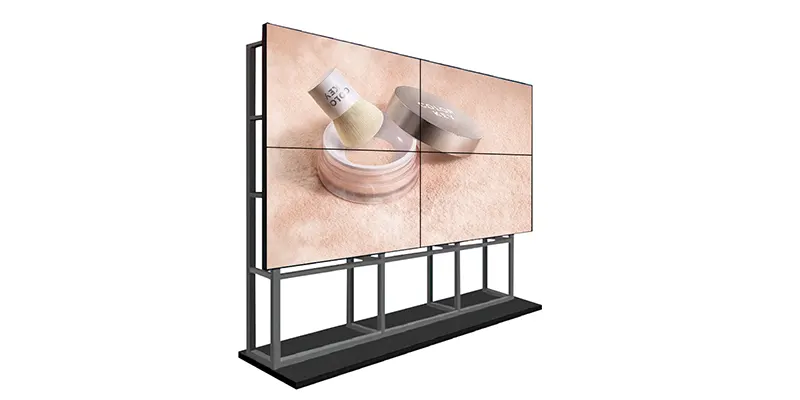What Is an LCD Video Wall and How Does It Work?
In this article, we will explore the ins and outs of LCD video walls, how they operate, and why they are such a game-changer in modern display technology.
1. Understanding the Basics of LCD Technology
What is LCD (Liquid Crystal Display)?
LCD, or Liquid Crystal Display, is a technology that uses liquid crystals to produce images on a screen. These crystals align themselves to either block or allow
light to pass through, creating pictures. Unlike older display technologies like CRT, LCD screens use no moving parts, making them thinner and more energy-efficient.
Components of an LCD display
Each LCD display in a video wall consists of layers that include the liquid crystals, a backlight, and polarizing filters. The backlight emits light that passes through the liquid crystals,
which adjust their alignment to produce various colors. The result is a bright and sharp image.
The Role of Bezel in LCD Video Walls
The bezel refers to the thin borders around each LCD display. In video walls, the bezel becomes important because it can break the seamless effect of the screen. Some modern LCD video
walls feature ultra-narrow bezels that minimize this issue, giving the illusion of one continuous display.
2. How Does an LCD Video Wall Work?
The Concept of Video Wall Configuration
LCD video walls are typically arranged in a grid pattern, with several panels creating one large, continuous screen. The configuration can range from a simple 2x2 setup to larger walls with more panels,
depending on the display size required for a particular space.
The Role of a Video Wall Processor
A video wall processor is the device that manages the content displayed on the video wall. It takes in signals from various sources (such as computers, cameras, or media players)
and divides the image across the multiple panels. It ensures the visuals remain clear and synchronized, providing seamless integration.
Content Sources and Display Control
The content displayed on the video wall can range from a static image to dynamic video feeds. The ability to control the content on each screen in real-time is key to the versatility of
LCD video walls. Software platforms enable users to upload, manage, and schedule content remotely, making it easy to update the display.
3. The Benefits of LCD Video Walls
High-Resolution and Sharpness
One of the primary benefits of LCD video walls is their ability to display content in high resolution. As each panel contributes to the overall picture, the more panels you have,
the higher the overall resolution, leading to a sharp, detailed image that can be seen from a distance.
Scalability and Flexibility
LCD video walls are highly scalable. Whether you need a small 2x2 display for a retail environment or a massive 10x10 wall for a large event, the modular nature of LCD technology makes
it easy to scale up or down according to the needs of the space.
Energy Efficiency
LCD video walls display are designed to consume less power compared to older technologies like plasma screens or CRTs. The energy efficiency makes them a cost-effective option for
large-scale installations that need to run continuously.
4. Types of LCD Video Walls
Standard LCD Video Walls
Standard LCD video walls display are made up of traditional LCD panels arranged in a matrix. These are commonly used in offices, retail environments, and small control rooms
where a standard resolution is sufficient for the job.
Ultra-Narrow Bezel Video Walls
These video walls use LCD panels with ultra-narrow bezels that minimize the gap between individual panels. This makes the overall display look like a single, uninterrupted screen,
perfect for applications that require a seamless viewing experience.
Touchscreen LCD Video Walls
Some LCD video walls are equipped with touchscreen capabilities, allowing users to interact with the content displayed. These are commonly found in interactive kiosks,
wayfinding systems, and exhibitions where audience engagement is required.
5. Applications of LCD Video Walls
Corporate and Office Environments
LCD video walls are becoming a staple in corporate settings, where they are used for presentations, data visualization, and internal communications. Their large format makes
them ideal for displaying important information to a large audience in conference rooms or lobbies.
Retail and Marketing
In retail environments, businesses use LCD video walls for dynamic advertising, promotions, and interactive displays. These walls capture attention with their size and clarity,
making them an excellent tool for marketing campaigns.
Public Displays and Events
LCD video walls are commonly used in public spaces and events, such as concerts, sports arenas, and exhibitions. They help convey information to large crowds, display live feeds,
and create engaging experiences for attendees.
Conclusion
LCD video walls are a powerful, flexible, and cost-effective solution for a wide range of applications. Their ability to display high-resolution content on a large scale, combined with their
energy efficiency and durability, makes them a popular choice for everything from corporate offices to public events. As technology continues to evolve, we can expect even more advanced
features and applications for these impressive displays.
For more product information, please contact us!
FAQs from the article:
1. What is the lifespan of an LCD video wall?
An LCD video wall typically lasts anywhere from 50,000 to 100,000 hours, depending on the quality of the panels and how well it is maintained.
2. How much does an LCD video wall cost?
The cost of an LCD video wall can vary significantly depending on factors like the size, number of panels, bezel type, and installation complexity. On average, a small setup can cost several thousand dollars,
while larger configurations can go well beyond that.
3. What are the best brands for LCD video walls?
Some of the best-known brands in the LCD video wall display market include Samsung, LG, and NEC. These companies are renowned for their high-quality panels, durability, and advanced features.


